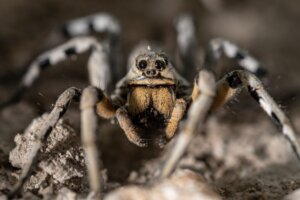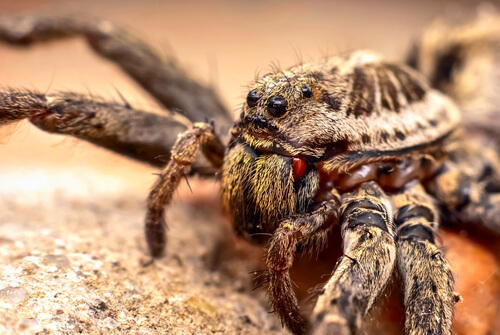The Wolf Spider: Habitat, Behavior, and Characteristics


Written and verified by the psychologist Sara González Juárez
You’ll probably think you’ve found a tarantula if you come across one of these impressive arachnids. However, the wolf spider is classified in another taxonomic group due to certain unique characteristics.
In fact, these invertebrates belong to the family of lycosids, a word that comes from the Greek lycos, hence the nickname “wolf” in their name. But they aren’t special just because of this curiosity; they’re arachnids with amazing abilities and it’s always good to get to know the wonders of nature a little better, so please read on!
Wolf spider characteristics
The appearance of the wolf spider is imposing. Its body is covered with hairs, 8 eyes, and long legs that go unnoticed by the chelicerae on its face. It easily camouflages thanks to the brownish shades it has. It’s logical that it has received this nickname.
This family of arachnids has 123 genera and 2398 different species.
In addition, the specimens of this family of arachnids are usually large in size. In addition, they’re nocturnal, which is why they have such a fine sense of sight and touch.

Habitat
Wolf spiders can be found all over the world (except in the Poles), although in the West, the genus Lycosa predominates, often confused with tarantulas. The greatest concentration of these arachnids, however, is found in the U.S. state of North Carolina.
They usually inhabit wooded areas, prairies, mountains, and deserts in a wide variety of climates, preferably humid and warm. Even so, each species is prepared to withstand the climatology of its particular biome.
Feeding
As you can imagine, these spiders are strict carnivores. In addition, not only do they feed on insects, but larger species may even prey on small reptiles if the opportunity arises.
Hunting behavior
Unlike other spiders and due to their size, these spiders don’t spin webs suspended in the air. Instead, they create vertical burrows in the ground, where they hide and lie in wait for prey.
Some genera, such as the Pirate, are curiously named for their ability to run through water or dive to escape predators.
Although venomous, they aren’t capable of killing an adult human. In most cases, their bite produces the same pain as a bee sting. It’s common for wolf spiders to sneak into homes looking for small insects and dark places to hide.
General behavior
Wolf spiders are nocturnal and solitary. They only meet others of their species during the breeding season. Most of the day is spent inside its burrow, a funnel-shaped hole in the ground that it covers with leaves and other debris to hide the entrance. They also often cover the walls with silk.
They also spend the winter hibernating in these burrows.
Because they burrow in the ground, they’re particularly sensitive to vibrations. This is why they tend to flee from humans and are harmless if left undisturbed. In fact, when they feel in danger they’re able to emit a sound that can be heard 10 meters (33 feet) away, so it’s difficult to disturb them unintentionally.
Their 8 eyes are positioned in such a way as to allow them excellent peripheral vision. As would be expected, they’re able to see in the dark and use this ability to catch their prey with surprising speed.
Wolf spider reproduction
Wolf spiders seek each other out during the spring mating season. It’s usually the male who searches for the female, selecting the deepest and best burrows, as this is a good indicator of the risk she had of being eaten.
Once there, they court them with rhythmic movements of their pedipalps and by raising their forelegs. When the female is willing, the male positions himself on the cephalothorax and fertilizes her.
Females usually kill the males when copulation is complete.
Females, after fertilization, usually make a spherical sac with silk to carry the eggs and “wear” it hanging from their abdomen. Unlike other spider families, they exhibit parental care behavior, carrying their young in their abdomen until their first molt.

There’s a great variety of wolf spiders, some larger and some smaller. Knowing their nature and behavior is essential in order to understand their role in the ecosystem and, above all, to be aware that their frightening appearance isn’t a reason to kill them. They’re very valuable members of the food chain and their absence has a significant impact on the environment.
So, if you’re interested in these arachnids, you should know that the genus Lycosidae has very interesting species that are worth studying individually. We encourage you to continue researching about them, you’ll be fascinated by what you find.
You’ll probably think you’ve found a tarantula if you come across one of these impressive arachnids. However, the wolf spider is classified in another taxonomic group due to certain unique characteristics.
In fact, these invertebrates belong to the family of lycosids, a word that comes from the Greek lycos, hence the nickname “wolf” in their name. But they aren’t special just because of this curiosity; they’re arachnids with amazing abilities and it’s always good to get to know the wonders of nature a little better, so please read on!
Wolf spider characteristics
The appearance of the wolf spider is imposing. Its body is covered with hairs, 8 eyes, and long legs that go unnoticed by the chelicerae on its face. It easily camouflages thanks to the brownish shades it has. It’s logical that it has received this nickname.
This family of arachnids has 123 genera and 2398 different species.
In addition, the specimens of this family of arachnids are usually large in size. In addition, they’re nocturnal, which is why they have such a fine sense of sight and touch.

Habitat
Wolf spiders can be found all over the world (except in the Poles), although in the West, the genus Lycosa predominates, often confused with tarantulas. The greatest concentration of these arachnids, however, is found in the U.S. state of North Carolina.
They usually inhabit wooded areas, prairies, mountains, and deserts in a wide variety of climates, preferably humid and warm. Even so, each species is prepared to withstand the climatology of its particular biome.
Feeding
As you can imagine, these spiders are strict carnivores. In addition, not only do they feed on insects, but larger species may even prey on small reptiles if the opportunity arises.
Hunting behavior
Unlike other spiders and due to their size, these spiders don’t spin webs suspended in the air. Instead, they create vertical burrows in the ground, where they hide and lie in wait for prey.
Some genera, such as the Pirate, are curiously named for their ability to run through water or dive to escape predators.
Although venomous, they aren’t capable of killing an adult human. In most cases, their bite produces the same pain as a bee sting. It’s common for wolf spiders to sneak into homes looking for small insects and dark places to hide.
General behavior
Wolf spiders are nocturnal and solitary. They only meet others of their species during the breeding season. Most of the day is spent inside its burrow, a funnel-shaped hole in the ground that it covers with leaves and other debris to hide the entrance. They also often cover the walls with silk.
They also spend the winter hibernating in these burrows.
Because they burrow in the ground, they’re particularly sensitive to vibrations. This is why they tend to flee from humans and are harmless if left undisturbed. In fact, when they feel in danger they’re able to emit a sound that can be heard 10 meters (33 feet) away, so it’s difficult to disturb them unintentionally.
Their 8 eyes are positioned in such a way as to allow them excellent peripheral vision. As would be expected, they’re able to see in the dark and use this ability to catch their prey with surprising speed.
Wolf spider reproduction
Wolf spiders seek each other out during the spring mating season. It’s usually the male who searches for the female, selecting the deepest and best burrows, as this is a good indicator of the risk she had of being eaten.
Once there, they court them with rhythmic movements of their pedipalps and by raising their forelegs. When the female is willing, the male positions himself on the cephalothorax and fertilizes her.
Females usually kill the males when copulation is complete.
Females, after fertilization, usually make a spherical sac with silk to carry the eggs and “wear” it hanging from their abdomen. Unlike other spider families, they exhibit parental care behavior, carrying their young in their abdomen until their first molt.

There’s a great variety of wolf spiders, some larger and some smaller. Knowing their nature and behavior is essential in order to understand their role in the ecosystem and, above all, to be aware that their frightening appearance isn’t a reason to kill them. They’re very valuable members of the food chain and their absence has a significant impact on the environment.
So, if you’re interested in these arachnids, you should know that the genus Lycosidae has very interesting species that are worth studying individually. We encourage you to continue researching about them, you’ll be fascinated by what you find.
All cited sources were thoroughly reviewed by our team to ensure their quality, reliability, currency, and validity. The bibliography of this article was considered reliable and of academic or scientific accuracy.
- Bristol Zoological Society. (s. f.). Desertas wolf spider. Consultado el 24 de abril de 2023. https://bristolzoo.org.uk/save-wildlife/conservation-and-research/desertas-wolf-spider-project
- Britannica, T. Editors of Encyclopaedia (2023, 16 de enero). Wolf spider. Encyclopedia Britannica. https://www.britannica.com/animal/wolf-spider
- Catalogue of life. (2022). Lycosidae. https://www.catalogueoflife.org/data/taxon/C9K
- Clemente, C., McMaster, K., Fox, E., Meldrum, L., Stewart, T., & York, B. (2010). The visual system of the Australian wolf spider Lycosa leuckartii (Araneae: Lycosidae): visual acuity and the functional role of the eyes. The Journal of Arachnology, 38(3), 398-406. https://bioone.org/journals/the-journal-of-arachnology/volume-38/issue-3/B09-96.1/The-visual-system-of-the-Australian-wolf-spider-Lycosa-leuckartii/10.1636/B09-96.1.short
- Isbister, G. K., & Framenau, V. W. (2004). Australian wolf spider bites (Lycosidae): clinical effects and influence of species on bite circumstances. Journal of toxicology. Clinical toxicology, 42(2), 153–161. https://pubmed.ncbi.nlm.nih.gov/15214620/
- Jocqué, R., & Alderweireldt, M. (2005). Lycosidae: the grassland spiders. Acta zoologica bulgarica, (Suppl. 1), 125-130. https://www.researchgate.net/publication/265488275_Lycosidae_The_grassland_spiders
- Kronestedt, J. (1996). Vibratory communication in the wolf spider Hygrolycosa rubrofasciata (Araneae, Lycosidae). Revue Suisse de Zoologie, 341-354. https://www.researchgate.net/publication/266907942_Vibratory_communication_in_the_wolf_spider_Hygrolycosa_rubrofasciata_Araneae_Lycosidae
- Livshits, Z., Bernstein, B., Sorkin, L. N., Smith, S. W., & Hoffman, R. S. (2012). Wolf spider envenomation. Wilderness & environmental medicine, 23(1), 49–50. https://pubmed.ncbi.nlm.nih.gov/22441089/
- Piacentini, L. N., & Ramírez, M. J. (2019). Hunting the wolf: a molecular phylogeny of the wolf spiders (Araneae, Lycosidae). Molecular Phylogenetics and Evolution, 136, 227-240. https://www.sciencedirect.com/science/article/abs/pii/S1055790318307607
- Rypstra, A. L., Schlosser, A. M., Sutton, P. L., & Persons, M. H. (2009). Multimodal signalling: the relative importance of chemical and visual cues from females to the behaviour of male wolf spiders (Lycosidae). Animal Behaviour, 77(4), 937-947. https://www.sciencedirect.com/science/article/abs/pii/S0003347209000359
- Rypstra, A. L., Schmidt, J. M., Reif, B. D., DeVito, J., & Persons, M. H. (2007). Tradeoffs involved in site selection and foraging in a wolf spider: effects of substrate structure and predation risk. Oikos, 116(5), 853-863. https://onlinelibrary.wiley.com/doi/abs/10.1111/j.0030-1299.2007.15622.x
- Steve Jacobs. (2022, 18 de noviembre). Wolf Spiders. Penn State’s College of Agricultural Sciences. https://extension.psu.edu/wolf-spiders
- Tahir,H., Zahra, K., & and Khan, A. (2018). Insect-specific peptides in the venom of wolf spiders (Araneae: Lycosidae). Turkish Journal of Zoology, 42(5), 614-616. https://journals.tubitak.gov.tr/zoology/vol42/iss5/11/
- Tomasinelli, F. (2018). Lobos de ocho patas. Introducción a las arañas lobos. Reptilia, 60-67. https://reptilia.es/wp-content/uploads/2018/02/043.pdf
- Universidad de Antioquía. (s.f.). Mordedura por arañas lobo. Consultado el 16 de abril de 2023. https://www.udea.edu.co/wps/wcm/connect/udea/3dad457e-fcf1-4139-b112-58c8733e400d/Lycosa.pdf?MOD=AJPERES&CVID=nfFGoKm
- Universidad de Granada. (s.f.). Lycosidae. Consultado el 16 de abril de 2023. https://ccz.ugr.es/es/museovirtual/Arthropoda/189423#
This text is provided for informational purposes only and does not replace consultation with a professional. If in doubt, consult your specialist.








